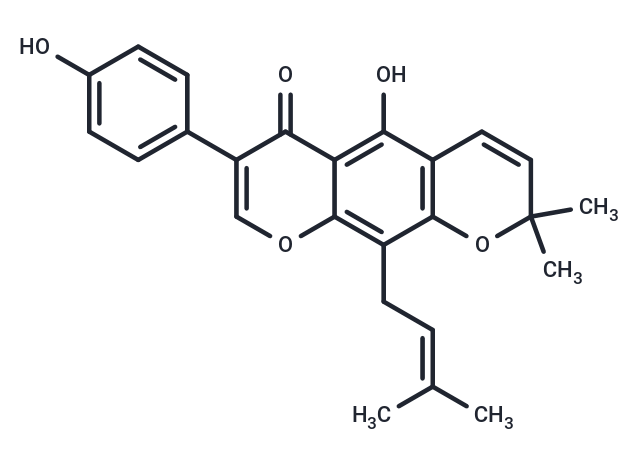Shopping Cart
- Remove All
 Your shopping cart is currently empty
Your shopping cart is currently empty

Warangalone is an anti-malarial compound that inhibits the growth of Plasmodium falciparum strains 3D7 (chloroquine-sensitive) and K1 (chloroquine-resistant) with IC50 values of 4.8 μg/mL and 3.7 μg/mL, respectively.

| Pack Size | Price | Availability | Quantity |
|---|---|---|---|
| 5 mg | $1,758 | Backorder |
| Description | Warangalone is an anti-malarial compound that inhibits the growth of Plasmodium falciparum strains 3D7 (chloroquine-sensitive) and K1 (chloroquine-resistant) with IC50 values of 4.8 μg/mL and 3.7 μg/mL, respectively. |
| Targets&IC50 | Parasite (K1):3.7 μg/mL, Parasite (3D7):.8 μg/mL, CAK:3.5 μM |
| In vitro | Warangalone can also inhibit cyclic AMP-dependent protein kinase catalytic subunit (cAK) with an IC50 of 3.5 μM [2]. When HL-60 cells are exposed to Warangalone (30 μM) for 24 h, Warangalone induces a significant decrease (8%) in cell viability compared to controls. Warangalone also inhibits HL-60 cell growth within 24 h in a time-dependent fashion. A time-dependent increase in caspase-9 activity is observed in Warangalone-treated cells [3]. |
| Kinase Assay | Cells are seeded in 24-well plates at a density of 3×10^6 cells per well. After exposure of the cells to Warangalone for the allotted time periods, the cells are washed three times with PBS and then lysed in a lysis buffer for 10 min on ice. The protein content of the cell lysates is assayed with a Micro BCA reagent. Cell lysates containing 50 μg of protein are incubated with a caspase-3 fluorogenic substrate (DEVD-AFC) or a caspase-9 fluorogenic substrate (LEHD-AFC) for 1 h at 37°C. Caspase activity is measured by fluorometric detection [3]. |
| Cell Research | Cells are seeded in 96-well plates at a density of 1×10^5 cells per well. The cells are maintained for 24 h at 37°C and then Warangalone (30 μM) is added to the culture medium. MTS solution is added to the 96-well plates at the indicated time points, and the cells are incubated for 1 h at 37°C. The absorbance is measured at a wavelength of 490 nm with a microplate counter [3]. |
| Alias | Scandenolone |
| Molecular Weight | 404.46 |
| Formula | C25H24O5 |
| Cas No. | 4449-55-2 |
| Relative Density. | 1.258g/cm3 |
| Storage | Powder: -20°C for 3 years | In solvent: -80°C for 1 year | Shipping with blue ice. |
| Solubility Information | DMSO: Soluble |

Copyright © 2015-2025 TargetMol Chemicals Inc. All Rights Reserved.